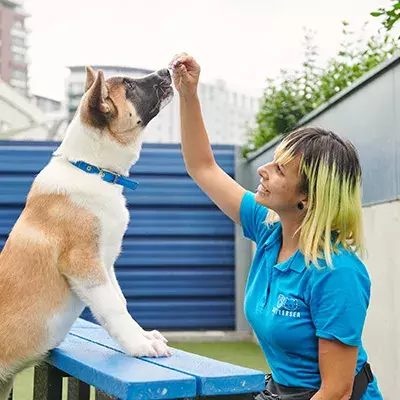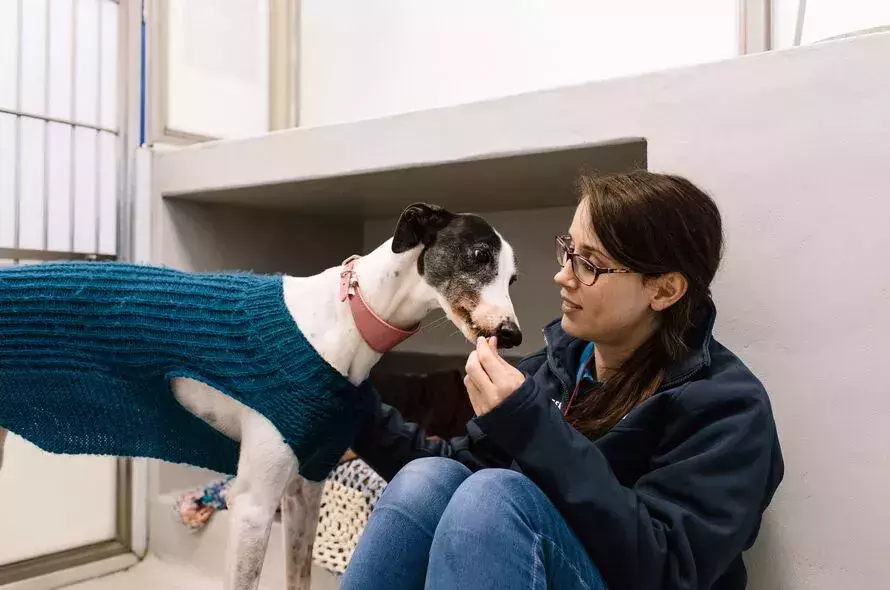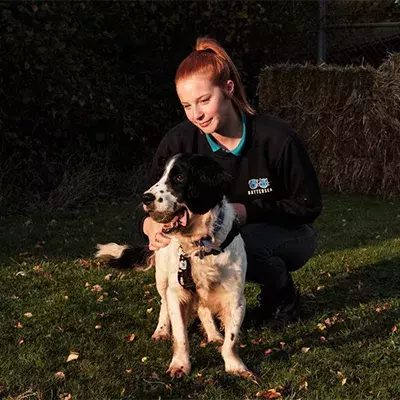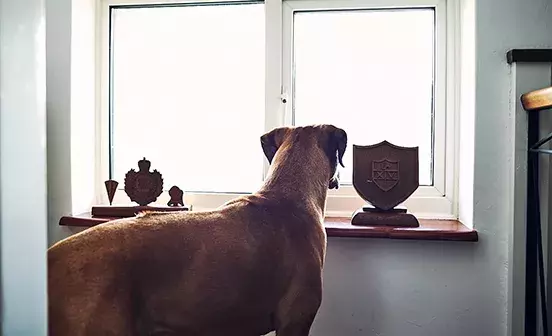If your dog is wary of strangers it’s often because of a certain amount of fear, so it’s important that training is done gradually, at their own pace, and without putting any pressure on them.
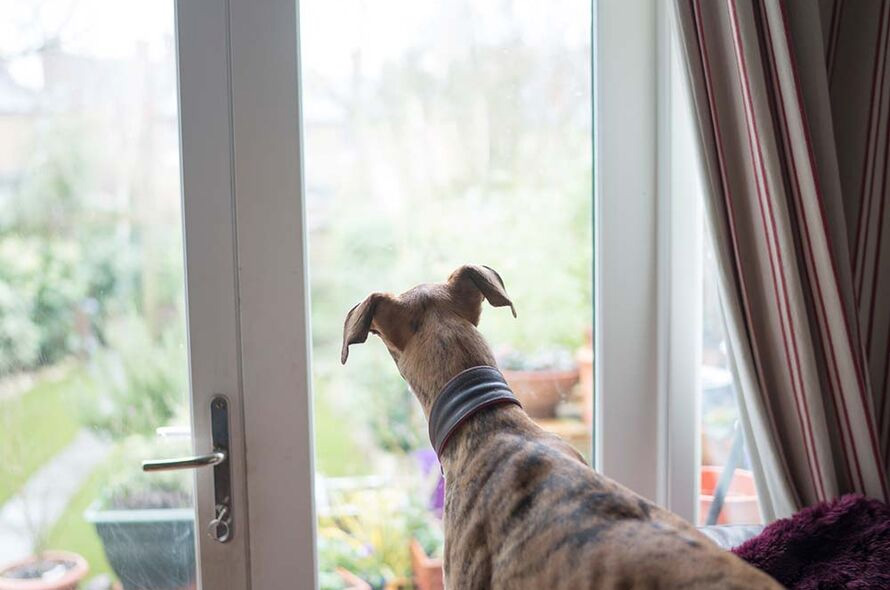
The best approach for your dog will depend on why your dog is fearful of strangers and where they tend to react to them, either at home or when out and about. If your dog shows severe reactions to strangers, or you feel like they need to wear a muzzle to safely be around new people, you should contact a qualified behaviourist who can offer one to one specialist training to you and your dog. Here are some steps that can help your dog build a more positive association toward strangers both at home, and out and about.
Take a look at our advice video on helping your dog to deal with strangers, or follow along with the steps below:
Dealing with stranger issues at home
Step 1
The first thing you can do to help your dog at home is make sure they don’t have immediate access to the front door. This will enable you to manage the situation when a potential stranger arrives. Where possible, use a baby gate to section off a ‘safety room’ that your dog is comfortable in, but a visitor will not need to enter. Place your dog in this room before a visitor arrives, or is allowed in.
Step 2
With this training, it’s a good idea to ask a friend or family member your dog’s not familiar with to help. Arrange a time when they have a spare hour-or-so and invite them over. When they arrive, ask them to knock on the door, but before they knock, place your dog in their safety room, behind the baby gate, and show them their reward. This can be a toy or a treat, depending on what they enjoy most.
When you answer the door, do not look at or talk to your dog and ask your visitor to do the same; then lead your guest into a separate room where you can both sit down.
Step 3
Once your guest is settled and your dog is calm, you can open the baby gate and invite them into the room. If your dog chooses to stay where they are, despite the baby gate being open, that is fine, we do not want to force an interaction.
Ask your visitor to remain relaxed and to completely ignore your dog, this includes no looking, touching or talking to them.
Step 4
The key now is to consistently praise and reward your dog for any calm and quiet behaviour they show, for example if they look at your guest without reacting or if they settle down somewhere.
If your dog is continuously barking, tense or seem like they are overwhelmed by the visitor, encourage them back to their safety room with food or toys until they are calm again.
Step 5
It is important that you are the one rewarding your dog and not your visitor. They may feel conflicted about taking a tasty treat from a stranger and we do not want to force them to interact.
Even if your dog is settling well and showing calm behaviours, do not ask your visitor to approach them. This may be overwhelming and could undo the great work you’ve done helping them to relax.
When your visitor is ready to leave, encourage your dog back into their safety room with food and toy. Have your visitor calmly leave, whilst continuing to ignore your dog.
In time, these steps can help your dog to learn that having visitors can be very rewarding!
Dealing with stranger issues when out and about
Step 1
If your dog has issues with strangers outside the home, it’s important to consider where and when you are walking them. You may find certain areas or times in the day are busier and you should ideally avoid these times to try and reduce the number of potential stressors for your dog.
Step 2
Before, you will need to teach your dog to respond to “This way” – this is an easy cue that will help when training a fearful dog.
To teach “This way”, begin in a quiet environment. Have your dog standing or sitting next to you, as if going for a walk, with both of you facing the same direction.
Have a tasty treat to hand or your dog’s favourite toy and let them see or smell it.
Next, turn around and face the opposite direction and jog a few paces with the treat or toy as a lure, whilst excitedly saying “This way!”. Reward your dog for following you.
Repeat these steps and continue to build up this cue in different environments with more distractions.
Step 3
Once your dog knows “This way”, you can begin to build a positive association with strangers. It may be useful to ask another friend who hasn’t met your dog to help out as your ‘stranger’. This will mean you can be in better control of the environment and will give your dog the best chance of succeeding.
Begin your training in a calm, familiar environment without too many distractions. Have your strange stand or sit still at a distance, and reward your dog whenever they look at the stranger while remaining calm.
If your dog is reactive or tense at this point, you need to increase the distance you are working from and try again.
Step 4
Next, we can move closer toward the stranger. Dogs find it intimidating to approach things they fear head on, so it is best to use a zig zag pattern from side to side as you walk. This will also prevent you from moving too close too quickly.
Zig zag slowly towards your stranger, rewarding your dog for calm behaviour.
If your dog shows signs of becoming uncomfortable, use your “This way” cue to encourage them back to a distance they were comfortable with.
Keep sessions short, only 5-10 minutes at a time, and always end your sessions by using your “This way” cue and rewarding your dog as you lead them away.
Step 5
If your dog was comfortable with that first distance, the next time you repeat this exercise you can start closer to the stranger.
If they react, this means you’ve got too close too quickly. If this happens, simply use your “This way” cue to bring your dog back to a more comfortable distance again.
Over time, you will be able to continue decreasing the distance.
Dealing with a stranger coming towards your dog
If someone your dog doesn’t know approaches you, keep an eye on your dog’s reactions, and reward them if they remain calm.
If they seem unsure, use your “This way” cue to encourage your dog to move away from the person, and reward them when they come with you. This teaches them to make a good choice by moving away from things that scare them.
When moving your dog away, as much as possible, stay calm and keep your voice and movements relaxed. Reward them for eye contact with you or loose lead walking. Rushing away or panicking can make your dog more anxious.
If your dog reacts straight away, it is likely the stranger is too close to begin with. Calmly encourage your dog away and reward them when they follow you.
